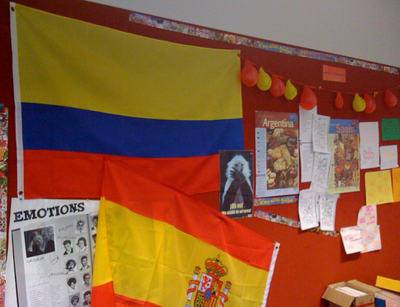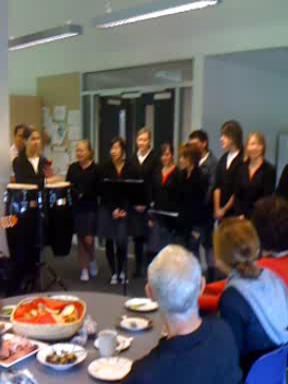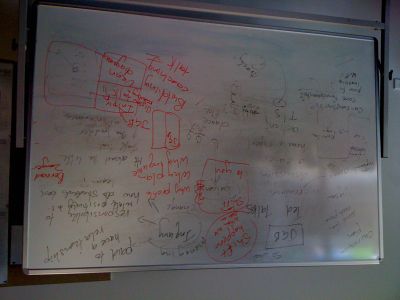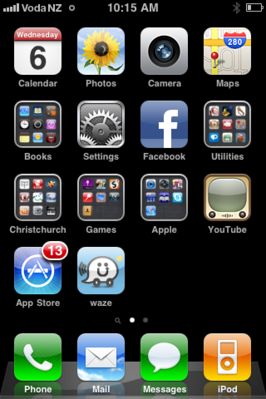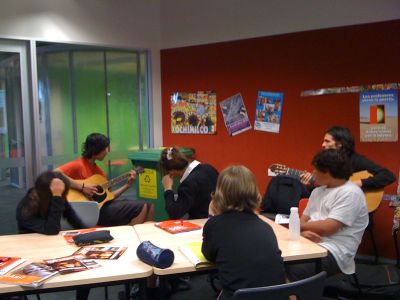Albany Senior High School/Curriculum plans/Languages
Curriculum Plan for Languages
Contents
- 1 Vision for the International Languages Department
- 2 Values
- 3 Expectations for teaching and learning including embedding ICT
- 4 Key competencies
- 5 Curriculum design
- 6 Quality Assurance Plan
- 7 Self review
Vision for the International Languages Department
We are blessed with bilingual brains.By learning a new language, students at ASHS will be nurtured, inspired and empowered through:
- developing the knowledge and skills necessary to become confident linguists able to communicate in a global community.
- understanding that different cultures have their own streams of thoughts and practices and actively engage to learn about it while exploring one's own personal world
- be in charge of their learning by becoming active participants in creating authentic contexts which will enable them to explore language to make meaning and will promote life long learning.
Values
How will we affirm and promote the school’s values?
- We will promote Excellence in all we do by providing an authentic learning environment, support for individualised language learning and having high expectations for student achievement
- Warm, mutually respectful relationship by openly listening to one another and understanding differences as a common ground for discussion.
- Fairness, openness, honesty and trust through modeling behaviour, transparency and open lines of communication.
- Learning together and making decisions through having students’ input into their learning, having good open practices in teaching, critically analysing their own actions and ideas and their impact on different cultures.
- Using evidence and reflection through making decisions, having wise choices, assessing and reassessing our practice, time and skills, and giving the students the time and space to reflect upon their own learning and how it influences the way they interact in a global community.
- Curiosity and enquiry, creativity and innovation through our own passion for our subject areas, connecting with students’ interest, their motivation and enhancing learning through providing an authentic learning environment coupled with authentic pedagogy.
- Contributing in our local and global community by forging links with education institutions (preschool primary and secondary schools, Universities) as well as businesses, local bodies and parents and the wider communities of the target languages taught.
- Protecting and enhancing the environment by exploring different cultures and their environmental climate and how changes can affect the global community, use of ICT instead of paper trails, recycling.
- Diversity that enriches our learning community through acknowledging and embracing cultural and language diversity through understanding of different societies, cultures and modes of communication.
- Families as a part of our learning community by ‘open door’ policy, showcase of students’ work, database, sharing success stories of achievement and sustained feedback back to the families.
- Honoring the unique place of Maori as tangata whenua through acknowledging it and comparing/ contrasting with other cultures, use Te Reo, incorporate it in lessons as part of become aware of how different languages work to convey meaning.
- By encouraging students to express their own values, explore with empathy the values of other cultures and critically analyse and compare them
Expectations for teaching and learning including embedding ICT
How will our teaching and learning meet the school’s expectations for 21st century pedagogy based on current research?
It will be aligned with the ASHS teaching portrait, school curriculum and assessment policy.
We will also use the AKO philosophy to guide our curriculum development.
|
How will we ensure students: Know what they are learning and why? Transparency/ using the split screen lesson plans to make learning processes explicit/ involve students in the planning process as well as assessing their prior knowledge by profiling and providing immediate feedback
Connect learning to real life situations? Create and use new knowledge based on authentic situations (via skype/ text/ virtual community/ trips/live TV/ radio), teach skills that are meaningful in the real world, make connections to the students' personal interests.
Have multiples opportunities to build on existing knowledge? Provide opportunities for students to share prior knowledge and tapping into their own interests, exploring their world and allowing for learning that extends outside school via impact projects, online blogs and eportfolios, wikis, collaborative and cross curricular links.
Examine and use new knowledge? Create knowledge that is socially bound, examine the newly creating knowledge by using it in a social context and examine how it affects the community and different cultures. Performativity, collaboration, web based inquiry and research will be the key components of this process as well as assessment time.
Have time to reflect on their learning? Ask the right questions, respond and reflect to critiqued material, formative assessment, student evaluation and use of e-portfolios. Provide instant feedback and feedforward to allow for 'in the nick of time' reflection time. |
How will our assessments provide effective learning?
By using data gathered through assessment to monitor that programmes are addressing learning needs of students |
What does an effective 100-minute lesson look like?
Key competenciesHow will we develop each of the key competencies in the learning area? How will we promote the split screen?
We will make these explicit by using the split screen approach during lessons to identify and explain the purpose of various activities and relating them to the real life learning.
Thinkingwill be developed through the use of diary entries as means of revising material taught, reflection about own learning, research undertaken for cultural aspects and making sense of the information acquired. Students will be encouraged to actively use the language they are studying to make meaning and use it within new language contexts. Through using critical and metacognitive processes, students will learn how to make sense of new grammatical concepts of the language they are studying and how to make connections with English.
|
| |
Curriculum design
What do we want our students to learn and/or develop?
'Learning a new language provides a means of communicating with people from another culture and exploring one's own personal world. Languages are inseparably linked to the social and cultural contexts in which they are used. Languages and cultures play a key role in developing our personal, group, national, and human identities. Every language has its own way of expressing meanings, each has intrinsic value and special significance for its users' (NZC, 2007. pg.28)
To learn how to use language to make meaning and to become effective communicators in their chosen language/ languages.
To develop their receptive skills of listening, reading and viewing and the productive skills of speaking, writing, presenting and performing.
To understand how language work, learn about the relationship between different words and different structures. How language is adjusted in different contexts and purposes (formal, colloquial, slang) to negotiate meaning.
To acquire skills that will allow them to become life-long language learners by being able to further their knowledge of the language chosen.
To develop their understanding of different cultures, and the strength of the interrelationship between language and culture and to respond to it in a productive manner.
To become aware how different cultures use their own set of systems and seek to understand the ways in which these systems are expressed.
To compare and contrast different beliefs and cultural practices , including their own in order to understand more about themselves and become more understanding of others.
To develop their understanding of the power of language, and discover how to use it to convey meaning, reflect upon their learning and respond appropriately
The Languages curriculum design will actively follow the circle of teaching inquiry by:
Focusing inquiry: actively deciding what is important and relevant to students, establishing a baseline and a clear direction of what the students need to be and what they need to learn.
Teaching inquiry: seeking strategies that are evidence based to motivate and engage students with their learning
Learning inquiry: reflecting on what happens as a result of teaching, investigate on the success of particular strategy and using a variety of appropriate assessment techniques.
Links to the 2011 ASHS Languages Courses:
wikieducator.org/Albany_Senior_High_School/Coursebook/1JAP
wikieducator.org/Albany_Senior_High_School/Coursebook/2JAP
wikieducator.org/Albany_Senior_High_School/Coursebook/3JAP
wikieducator.org/Albany_Senior_High_School/Coursebook/1SPA
wikieducator.org/Albany_Senior_High_School/Coursebook/2SPA
wikieducator.org/Albany_Senior_High_School/Coursebook/3SPA
wikieducator.org/Albany_Senior_High_School/Coursebook/1REO
wikieducator.org/Albany_Senior_High_School/Coursebook/2REO
Quality Assurance Plan
How will we ensure that standards are transparent, clear, reliable, valid and fair?
- By assessing standards that align themselves with what the students are learning- assessments that are appropriate to knowledge, skills and attitudes.
- By providing timely and ongoing feedback to the students
- By providing multiple opportunities for success
- By ensuring that there are school wide consistency of internal assessment procedures
- By creating assessment standards that comply with NZQA guidelines in terms of conditions, quality assurance, up to date versions and topics.
- By moderating standards prior to assessing them with colleagues from other schools
- By ensuring transparency and fairness of the same assessed standard between different classes and students.
- By submitting complete work of the assessed standard to NZQA for moderation and keeping all work assessed for the time suggested by NZQA.
- By providing documented evidence of assessment standard/ schedules/ student work
- By reviewing the standards against the recommendations made by the external moderators and changing it accordingly.
- By providing an annual report of NZQA data and commentary related to it.
International Languages Assessment Plan 2010/ 2011
Self review
What data will we collect and how will we use it?
Data will be collected and used according to the guidelines as set out in the ASHS Data Plan and Curriculum Policy.
The data will inform teachers as to the progress of their student's learning and effectiveness of the course programs
Achievement data from NCEA assessments can be used as a monitoring tool to inform choice of standards relevant to our students as well as appropriateness of the course material to the chosen standards.
Formative assessment will be an important measure of this data and is to be built into the course program. This will provide information in a "feed-flow" allowing timely, appropriate, relevant and efficient feedback to individual students and allow teachers to give informed feed-forward advice.
Examples: red flagging, comprehensive class profiles
Analysing internal data for summative assessment and use it to review units of work/ planning strategies for the future.
Self-review processes will include evaluation and reflection times based on our own teaching practices and students' evaluation and will be involving elements such as:
Student directed:
Challenge - to what extent does this activity make you want to get involved?
Skill - to what extent is this activity enabling you to use your skills?
Importance - to what extent is this activity important to you?
Interest and relevance- to what extent do you want to be doing this activity? is this activity interesting to you? are you concentrating on this activity?
Success - to what extent are you feeling successful at the current activity ? are you feeling in control as you work on this activity?
Relax - to what extent do you feel relaxed rather than anxious while you are doing this activity ?
Self esteem - to what extent are you feeling good about yourself as you do this activity?
Teacher directed:
We will use the following guidelines to inform our data collection and self review process as well. We know teaching is effective when teachers are genuinely:
questioning whether they are making the best possible use of the limited time for learning.
seeking ways of designing learning to maximise alignment (to what extent is what I am doing aligned to the learning intentions), engagement (to what extent are the students on-task and thinking about what they are doing) and success (to what extent are the students experiencing success)
collecting information that enables them to take better notice of the extent of the alignment, student engagement and student success.
responding to information about the extent of alignment, student engagement and student success.
